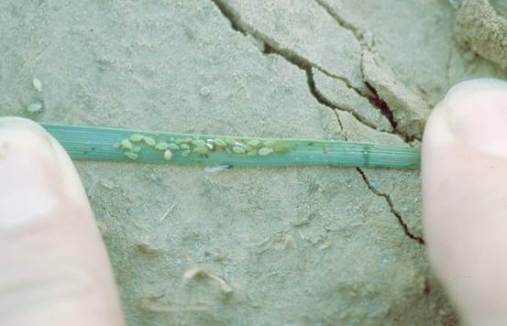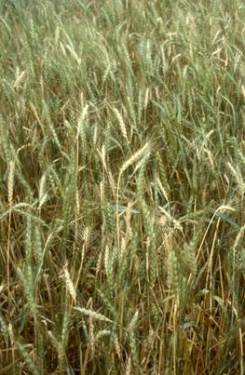Considerations to Make before Planting Wheat this Fall
Dr. Bob Hunger, Extension Wheat Pathologist
Dr. Tom Royer, Extension Entomologist
Department of Entomology & Plant Pathology
Oklahoma State University
Planting date: Much of the winter wheat in Oklahoma is sown with the intent of being used as a dual-purpose crop. In such a system, wheat is grazed by cattle during the late fall through early spring and then harvested for grain in early summer. In a grain-only system, wheat is generally planted in October, but in a dual-purpose system wheat is planted in early to mid-September to maximize forage production. Planting wheat early significantly increases the likelihood that diseases such as mite-transmitted viruses, the aphid/barley yellow dwarf complex, and root and foot rots will be more prevalent and more severe. For more detailed information on planting date and seed treatment considerations on wheat, see CR-7088 (Effect of Planting Date and Seed Treatment on Diseases and Insect Pests of Wheat) at:
http://pods.dasnr.okstate.edu/docushare/dsweb/Get/Document-7836/CR-7088web2012.pdf
Mite-transmitted virus diseases. These include wheat streak mosaic (WSM), wheat mosaic (formerly called high plains disease), and Triticum mosaic (TrM). All are transmitted by wheat curl mite (WCMs). WCMs and these viruses survive in crops such as wheat and corn, as well as many grassy weeds and volunteer wheat. In the fall, WCMs spread to emerging seedling wheat, feed on that seedling wheat, and transmit virus to the young wheat plants. In the spring of 2016, several fields of commercial wheat in north-central and northwestern OK were destroyed by WSM. These fields were growing immediately adjacent to fields left fallow during the fall/winter of 2015-2016. The fallow fields contained abundant volunteer wheat and grassy weeds from which WCMs carrying WSMV spread into the commercial fields. Wheat infected in the fall is either killed by the next spring or will be severely damaged. Hence, it is imperative to be a good neighbor and control volunteer wheat and grassy weeds in fields left fallow – especially, if they are adjacent to commercial wheat fields.
A commercial wheat field showing severe symptoms of wheat streak mosaic (left). The commercial field was infested during the fall and winter with wheat curl mites carrying the virus from volunteer wheat and grassy weeds that were not controlled in the fallow field. The picture on the right are typical foliar symptoms of WSM.


Seed treatments are not effective in controlling these mite-transmitted virus diseases. However, planting later in the fall (after October 1 in northern OK and after October 15 in southern OK) and controlling volunteer wheat are two practices that provide some control. It is extremely critical that volunteer wheat is completely dead for at least two weeks prior to emergence of seedling wheat because WCMs have a life span of 7-10 days. Thus, destroying volunteer wheat at least two weeks prior to emergence of seedling wheat will greatly reduce mite numbers in the fall. In addition to these cultural controls, two winter wheat varieties (RonL from Kansas and Mace from Nebraska) have resistance to WSM; however, their adaptation to production is limited to northwestern Oklahoma. For more information on mite-transmitted virus diseases, see OSU Fact Sheet 7328 (Wheat Streak Mosaic, High Plains Disease and Triticum Mosaic: Three Virus Diseases of Wheat in Oklahoma) at: http://pods.dasnr.okstate.edu/docushare/dsweb/Get/Document-8987/EPP-7328.pdf
Aphid/barley yellow dwarf (BYD) complex: Viruses that cause BYD are transmitted by many cereal-feeding aphids. BYD infections that occur in the fall are the most severe because virus has a longer time to damage plants as compared to infections that occur in the spring. Several steps can be taken to help manage BYD. First, a later planting date (after October 1 in northern Oklahoma and after October 15 in southern Oklahoma) helps reduce the opportunity for fall infection.Second, some wheat varieties (e.g., Duster, Endurance, Gallagher, Iba, Doublestop CL+, Bentley, Everest, Winterhawk, Redhawk) tolerate BYD better than other varieties; however, be aware that no wheat variety has a high level of resistance to the aphid/BYD complex. Third, control aphids that transmit the viruses that cause BYD. This can be done by applying contact insecticides to kill aphids, or by treating seed before planting with a systemic insecticide. Unfortunately, by the time contact insecticides are applied, aphids frequently have already transmitted the virus(es) that cause BYD. Systemic seed-treatment insecticides including Gaucho (imidacloprid) and Cruiser (thiamethoxam) can control aphids during the fall after planting. This may be particularly beneficial if wheat is planted early to obtain forage. Be sure to thoroughly read the label before applying any chemical.
Spot in field (top) of barley yellow dwarf (BYD) as would be seen in March or April. Many types of aphids (for example, greenbug; bottom) transmit the viruses that cause BYD.


Hessian fly: Hessian fly infestations occur in the fall and spring. Fall infestations arise from over-summering pupae that emerge when climate conditions become favorable.
Adult Hessian fly (left) and larvae and pupae of the Hessian fly (right)


Delayed planting (after October 1 in northern Oklahoma, and after October 15 in southern Oklahoma) can help reduce the threat of Hessian fly, but a specific “fly free date” does not exist for most of Oklahoma as it does in Kansas and more northern wheat-growing states. This is because smaller, supplementary broods of adult flies emerge throughout the fall and winter. Some wheat varieties are either resistant (e.g. Duster, Gallagher, SY-Southwind, LCS Wizard, Winterhawk) or partially resistant (e.g. Everest, Iba, Jackpot, PostRock, Ruby Lee, SY-Gold, T-153, Tam 304, WB-Stout) to Hessian fly infestations. Hessian fly infestations can be reduced somewhat by destroying volunteer wheat in and around the field at least two weeks prior to emergence of seedling wheat. Seed treatments that contain imidacloprid or thiamethoxam will also help reduce fly fall infestations, especially if combined with delayed planting and volunteer destruction. For more information on Hessian fly, see OSU Fact Sheet: EPP-7086 (Hessian fly Management in Oklahoma Winter Wheat) at:
http://pods.dasnr.okstate.edu/docushare/dsweb/Get/Document-6189/EPP-7086web2015.pdf
Root and foot rots: These include several diseases caused by fungi such as dryland (Fusarium) root rot, Rhizoctonia root rot (sharp eyespot), common root rot, take-all, and eyespot (strawbreaker). Be aware that in the late spring of 2016, several samples of wheat were received that were diagnosed as being affected by take all and other root rots. This could indicate a greater incidence of wheat root rots in 2017, but the incidence and severity of root rots is highly dependent on weather conditions so it is impossible to predict their incidence and severity this early.
Controlling root and foot rots is difficult. There are no resistant varieties, and although fungicide seed treatments with activity toward the root and foot rots are available, their activity usually involves early-season control or suppression rather than control at a consistently high level throughout the season. Often, there also are different “levels” of activity related to different treatment rates, so again, CAREFULLY read the label of any seed treatment to be sure activity against the diseases and/or insects of concern are indicated, and be certain that the seed treatment(s) is being used at the rate indicated on the label for activity against those diseases and/or insects. Later planting (after October 1 in northern Oklahoma and after October 15 in southern Oklahoma) also can help reduce the incidence and severity of root rots, but planting later will not entirely eliminate the presence or effects of root rots. If you have a field with a history of severe root rot, consider planting that field as late as possible or plan to use it in a “graze-out” fashion if that is consistent with your overall plan. For some root rots, there are specific factors that contribute to disease incidence and severity. For example, a high soil pH (>6.5) greatly favors disease development of the root rot called take-all. OSU soil test recommendations factor in this phenomenon by reducing lime recommendations when continuous wheat is the intended crop. Another practice that can help limit take-all and some of the other root rots is the elimination of residue. However, elimination of residue by tillage or burning does not seem to affect the incidence or severity of eyespot (strawbreaker).
White heads indicative of root rot (left); darkened roots (right) indicative of root rot (in this case, take all).


Seed treatments: There are several excellent reasons to plant seed wheat treated with an insecticide/fungicide seed treatment. These include:
1. Control of bunts and smuts, including common bunt (also called stinking smut) and loose smut. The similarity of these names can be confusing. All affect the grain of wheat, but whereas common bunt and flag smut spores carryover on seed or in the soil, loose smut carries over in the seed. Seed treatments are highly effective in controlling all the bunts/smuts. If common bunt (stinking smut) was observed in a field and that field is to be planted again with wheat, then planting certified wheat seed treated with a fungicide effective against common bunt is strongly recommended. If either common bunt or loose smut was observed in a field, grain harvested from that field should not be used as seed the next year. However, if grain harvested from such a field must be used as seed wheat, treatment of that seed at a high rate of a systemic or a systemic + contact seed treatment effective against common bunt and loose smut is strongly recommended. For more information on common bunt & loose smut, see: http://www.entoplp.okstate.edu/ddd/hosts/wheat.htm and consult the “2016 OSU Extension Agents’ Handbook of Insect, Plant Disease, and Weed Control (OCES publication E-832),” and/or contact your County Extension Educator.
2. Enhance seedling emergence, stand establishment and forage production by suppressing root, crown and foot rots. This was discussed above under “Root and Foot Rots.”
3. Early season control of the aphid/BYDV complex. This can be achieved by using a seed treatment containing an insecticide. Be sure that the treatment includes an insecticide labeled for control of aphids.
4. Control fall foliar diseases including leaf rust and powdery mildew. Seed treatments are effective in controlling foliar diseases (especially leaf rust and powdery mildew) in the fall, which may reduce the inoculum level of these diseases in the spring. However, this control should be viewed as an added benefit and not necessarily as a sole reason to use a seed treatment.
Suppression of early emerged Hessian fly. Research suggests that some suppression can be achieved, but an insecticide seed treatment has little residual activity past the seedling stage.